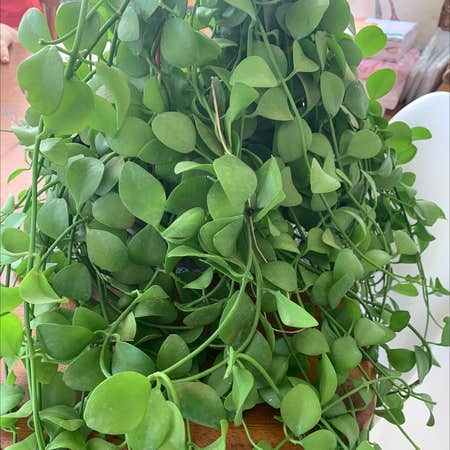Rod Dischidia představuje pozoruhodnou skupinu epifytických rostlin z čeledi toješťovitých (Apocynaceae), podčeledi klejichovitých (Asclepiadoideae). Tyto unikátní rostliny pocházejí z tropických oblastí Asie, Austrálie a Oceánie, kde přirozeně rostou přichycené na stromech a keřích. Jejich adaptace na tento způsob života je fascinující a projevuje se v mnoha neobvyklých tvarech listů a stonků.

Rozmanitost Rodu Dischidia: Každý Druh Je Originál
Rod Dischidia zahrnuje širokou škálu druhů, které se liší nejen vzhledem, ale i nároky na pěstování. Mezi nejznámější a nejoblíbenější patří například Dischidia nummularia, známá svými drobnými, kulatými lístky připomínajícími mince. Dalším zajímavým druhem je Dischidia pectinoides, která vytváří duté, baňkovité listy sloužící jako úkryt pro mravence. Tato symbiotická interakce je jedním z mnoha fascinujících aspektů těchto rostlin.
Dischidia nummularia: Drobné Mince Přírody

Dischidia nummularia, často nazývaná „řetízkové penízky“, je oblíbená pro své nenáročné pěstování a atraktivní vzhled. Její drobné, dužnaté, okrouhlé listy vyrůstají na tenkých, převislých stoncích, čímž vytvářejí elegantní závěsy. Je ideální rostlinou pro pěstování v závěsných květináčích nebo na vyvýšených místech, kde může plně vyniknout její krása.

Dischidia pectinoides: Mravenčí Domky a Zázrak Symbiózy
Dischidia pectinoides je skutečným unikátem. Její modifikované listy mají tvar dutých, baňkovitých struktur, které v přírodě slouží jako domov pro mravence. Rostlina z těchto mravenčích obydlí získává živiny z organického odpadu, zatímco mravenci nacházejí bezpečný úkryt. Tato fascinující symbióza činí z Dischidia pectinoides výjimečný kousek do každé sbírky.
Další Pozoruhodné Druhy Dischidia
Kromě výše zmíněných druhů existuje mnoho dalších zajímavých zástupců rodu Dischidia. Patří mezi ně například Dischidia oiantha s jejími voskovými květy, Dischidia ruscifolia s hustými, tmavě zelenými lístky, nebo Dischidia geri s nápadnými, stříbřitě skvrnitými listy. Každý druh nabízí něco jedinečného a přispívá k rozmanitosti tohoto pozoruhodného rodu.

Pěstování Dischidia: Tipy a Triky pro Zdravý Růst
Pěstování Dischidia může být velmi uspokojivé, pokud dodržíte několik základních pravidel. Jako epifytické rostliny preferují vzdušné a dobře propustné substráty. Ideální je směs kůry, kokosových chipsů a perlitu. Zálivka by měla být mírná a pravidelná, přičemž je důležité nechat substrát mezi zálivkami proschnout. Přemokření může vést k hnilobě kořenů.
Světlo: Klíč k Vitalitě a Kvetení
Většina druhů Dischidia preferuje jasné, nepřímé světlo. Přímé sluneční paprsky mohou spálit jejich citlivé listy. Východní nebo západní okno je obvykle ideální. Nedostatek světla může vést k pomalému růstu a absenci kvetení.
Voda a Vlhkost: Jemná Rovnováha pro Epifyty
Zálivka by měla být prováděna opatrně. Substrát by měl být vlhký, ale nikdy přemokřený. V zimních měsících zálivku omezte. Většina druhů Dischidia ocení vyšší vlhkost vzduchu. Pravidelné rosení nebo umístění v blízkosti zvlhčovače vzduchu může být prospěšné, zejména v suchém prostředí.

Substrát a Přesazování: Podpora Zdravých Kořenů
Jak již bylo zmíněno, ideální substrát pro Dischidia je vzdušný a dobře propustný. Přesazování se provádí jen zřídka, obvykle jednou za dva až tři roky, když rostlina přeroste svůj květináč. Volte mírně větší květináč a vždy použijte vhodný epifytický substrát.
Hnojení: Podpora Kvetení a Růstu
Během vegetačního období (jaro a léto) můžete Dischidia hnojit zředěným hnojivem pro epifytické rostliny nebo orchideje jednou za dva až čtyři týdny. V zimě hnojení vynechte.
Dischidia v Interiéru: Zelený Klenot Vašeho Domova
Díky svému neobvyklému vzhledu a relativní nenáročnosti na pěstování se Dischidia stává stále oblíbenější interiérovou rostlinou. Její převislé stonky a zajímavé listy dodají každému prostoru originální a exotický nádech. Skvěle se hodí do závěsných květináčů, na police nebo do terárií.
Závěsné Dekorace Plné Života
Dischidia vynikne zejména jako závěsná rostlina. Její dlouhé, převislé stonky s dekorativními listy vytvářejí působivé zelené kaskády, které oživí každý interiér.
Netradiční Rostlina pro Terária
Díky své toleranci k vyšší vlhkosti je Dischidia vhodnou rostlinou i pro pěstování v teráriích, kde může vytvářet zajímavé epifytické scenérie.
Závěr: Objevte Kouzlo Dischidia
Rod Dischidia nabízí fascinující pohled do světa epifytických rostlin. Jeho rozmanitost, neobvyklé adaptace a relativní nenáročnost na pěstování z něj činí atraktivní volbu pro každého milovníka rostlin. Ponořte se do světa těchto zelených klenotů a objevte jejich jedinečnou krásu a tajemství.
